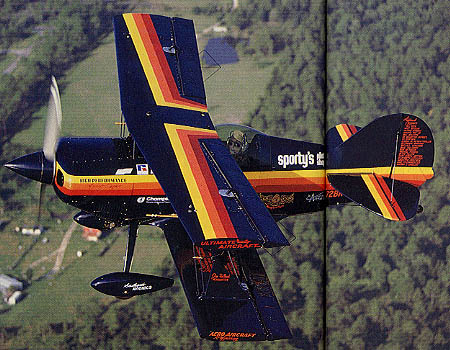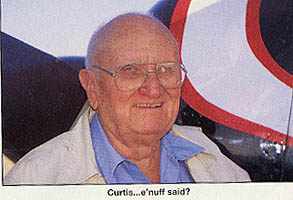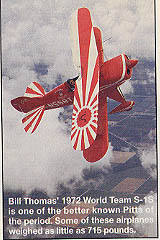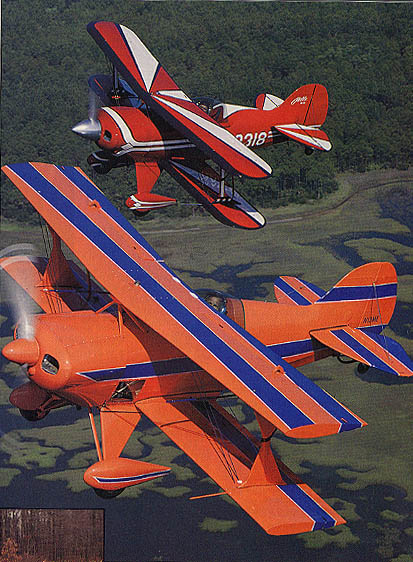There are Pitts Specials and there are other airplanes and the two shouldn't be confused. Davisson, '99
There are Pitts Specials and there are other airplanes and the two shouldn't be confused. Davisson, '99
Before moving up into an Extra, World Team member Ellen Dean campaigned a hotrod Pitts with Ultimate wings, spring gear and a go-for-broke Lycoming.

What's the old saying? What goes around comes around? In the case of the Pitts Special that saying could have double meanings, both in the airplane's basic purpose in life (goin' round and round) as well as the come-back phenomenon that seems to be in full swing.
In the 1960's and '70's every fly-in had rows upon rows of the diminutive little Pitts Specials. For a sizable segment of the biplane fraternity, which in those days was a sizable segment of the homebuilt movement, the Pitts Special was the ultimate way to go. In terms of aerobatics, it ushered in the era of true unlimited aerobatics. Other than the pilot's imagination, the airplane had no limitations and it became even more limitless as new versions mutated out of the old. Most Pitts, however, weren't built by aerobatic wannabes. They were built by people who appreciated a finely balanced, sprightly performer that was cute as a bug.
Then all of a sudden, Pitts Specials disappeared. In the 1980's it was as if epoxy vapors had killed off it's hatchlings. For a decade and a half what had been a common sight B.C. (before composites) became something so rare as to be commented on.
Beware: Your first flight in a Pitts is going to ruin you for any other airplane.
In the last several years, however, things seem to be changing. What went around is finally coming back around again: people are re-discovering the Pitts Special. Actually, what many are re-discovering is that there are literally hundreds, yes, hundreds of Pitts Specials out there that have either been lounging in a back hangar corner gathering dust or have been damaged and emotionally abandoned by a discouraged pilot. We're even seeing an increase in people building the airplane from scratch because the basic airframe is so inexpensive compared to more modern kit-only planes.
As chief instructor and janitor for a Pitts Special check-out school as well as being a card-carrying Pitts freak, I've found my phone suddenly ringing like crazy with requests for training in, or advice on, buying such an airplane. It appears Pitts Specials that have been dormant for a long time are being awaken by the dozens.
First let's hit one thing right up front: The Pitts Special's reputation for being a handful on the ground is grossly exaggerated. Grossly exaggerated! As Curtis once said, "There is no such thing as a squirrely airplane, just squirrely pilots." At the same time, however, if there was ever an airplane that needs a little appropriate training before flying it for the first time, this is the one.
The airplane actually has no characteristics of its own other than being smooth and eager to respond. Its only characteristic is that it exactly mimics the pilot. It will do only what the pilot asks it to do, it will do it immediately and will keep doing it until the pilot asks it to do something else.
This ability to mimic the pilot is where the reputation comes from: Most airplanes give a pilot time to make a movement, see what that movement does and then plan for the next movement. The Pitts doesn't give that leeway. If you make a movement with your hands or feet, you'd better know what your next move is going to be ahead of time because you'll find yourself there before you have time to think about it.
 After the first few hours, the
way it follows your hands and feet is a characteristic you'll
love because it gives you the ability to be tremendously precise
in all regimes of flight.
After the first few hours, the
way it follows your hands and feet is a characteristic you'll
love because it gives you the ability to be tremendously precise
in all regimes of flight.
While working your way through the first few hours, however, the way it follows your hands and feet can scare the devil out of you and generate a situation where you are fighting yourself, not the airplane.
Pitts Specials never go out of control on the runway by themselves. They are always forced out of control by a frantic pilot.
The first Pitts Special, which was powered by a 55 hp Lycoming, flew in 1945 and that is almost exactly the same airplane (with a bungee gear and metal turtledeck added) that Curtis Pitts offered as the S-1C in plans form beginning in 1960.
Incidentally, the "C" stood for Continental because Curtis envisioned the airplanes being built with 100 hp, 0-200 Continentals. Very, very few were so built. The airplane's very personality appeals to the go-fast crowd and only a few years later the 180 Lycoming became the aerobatic engine of choice.
A note about engines here: A light, small engine Pitts Special is a terrific airplane. I flew the 65 hp (that's right 65 hp!) Pitts S-1 replica built a few years back and it was a great performer because it only weighed 507 pounds. Almost no one NEEDS 180 hp, but everyone WANTS 180 hp. The airplane looses some of its gentle personality as the power and weight go up. A 600 pound, 100 hp airplane would surprise you. A light, 160 hp S-1C would be more airplane than 95% of the pilot population could ever use to the limit of its capabilities.
Let's talk the different models for a few minutes.
 FLATWING PITTS
FLATWING PITTS
The S-1C, usually called the Flatwing, uses a relatively flat-bottom M-6 airfoil and ailerons on the lower wings only. This is your classic flatwing as originally put out on plans.
You'll find a number of different fuselage lengths on the Flatwings. The original fuselage was pretty short in the cockpit so at some point in the late 1960's Curtis added three inches in the cockpit. Even he isn't sure when he made the change.
I've made an effort to resolve this question of fuselage length using two dimensions: The firewall to the cross tube at the top of the seat back and firewall to tailpost. Curtis has checked his drawings as best he can (most original drawings were destroyed) and we've measured a number of airplanes trying to nail this down, but bear in mind in homebuilt airplanes you're liable to find anything.
Original short S-1C Fuselage: F/W to seat back, 50 3/4"
F/W to tail post, 121 3/4" +/-
Lengthened S-1C fuselage: F/W to seat back, 53 3/4"
F/W to tailpost, 124 3/4 +/-
The symmetrical wing "Roundwing" S-1S Pitts was already on the scene when a relatively little known flat-wing version, the S-1D, was developed. The "D" is a flatwing with four ailerons and the longer fuselage of the later "S"s.
The only reason Curtis up-graded from the M-6 airfoil to the symmetrical wing in the mid-1960's is that the M-6 didn't give outside (inverted) performance of the quality then becoming so necessary in world competition. Unlimited competition is the only place the M-6 airfoil is a disadvantage and it will work well up through advanced category with the right set of hands at the controls. Don't forget that only a few years ago, Robert Armstrong flew his modified, two aileron, Flatwing on the US World team in France and he had fake ailerons airbrushed in the top wings :-).
The two-aileron airplanes roll at about 150°/sec and the four aileron at around 220°. Compared to the aerobatic super-ships that sounds slow. However, the first time a Spamcan pilot sees those kinds of roll rates coupled with the Pitt's instant response, it makes their eyeballs sweat.
 S-1S ROUNDWING PITTS
S-1S ROUNDWING PITTS
In the Roundwing, the Pitts hit what many consider to be its peak until the Super Stinker came along in 1994. It's symmetrical wings are parallel (same angle of incidence) and use different airfoil sections top and bottom to make the top wing stall first whether inverted or right side up. Curtis has a patent on this concept and it's used on all factory Pitts.
The S-1S doesn't know right side up from upside down and doesn't care. Coupled with light weight and a 180 Lycoming, there aren't three dozen pilots in the world who are better than this airplane. There's a tendency to think the high powered monoplane does better aerobatics, but it doesn't. It just does 'different" aerobatics, with lots of speed, long lines and punishing "G" forces. World competition demands those kinds of capabilities and the bigger airplanes are easier to judge. However, lower level competition, especially here in the US doesn't demand those kinds of characteristics.
Sport flying doesn't concern itself with any of the foregoing because first, last and always, the Pitts Special is a sport plane. Aerobatics is a pilot-controlled option that need not be used.
This isn't brain surgery, folks. If one person can do it, the rest can too.
Here too, weight is everything. Curtis says they put out some 180 hp Roundwings in the late 60's and early 70's that weighted only 715 pounds (!!). No electric, lightening holes everywhere, light finish, no radio, they were absolute rocket ships. The target weight with electric and all the accouterments we demand these days should be less than 750-770 pounds. With B & C light weight electrics or the equivalent, that should be, if not easy, at least possible. In reality, most S-1S's wieght over 800 pounds.
The "S" model Pitts was never available to the homebuilder in plans form from Curtis. Either he built them or they aren't true "S" models. Yes, there are lots of early homebuilt so-called S-1S models out there but, they don't usually use true S-1S wings. Curtis says a set of his original wing plans left his shop in a worker's lunch pail and shortly thereafter there were several other makes of Pitts wings available. The most commonly seen are from Sparcraft. They are identifiable because they generally use routed plywood ribs. They fly nearly as well as Pitts wings, but they aren't Pitts wings.
Another common wing is the square tipped Ultimate. This has ailerons running full length on all four wings so naturally it has a blinding roll rate, but they don't fly any better and some pilots report they increase the weight.
There's yet another recent variation on the wing in the new S-1SS wing from Steen Aerolab, the Skybolt people (704/652-7382). They sell plans for the S-1C as well as welded single-seat Pitts components. They worked with Curtis to develop a new wing for the four-cylinder Pitts series. This wing incorporates the aileron technology Curtis put in the Super Stinker, his six-cylinder Sukhoi-killer. These wings increase the roll rate significantly without the use of spades and can be put on any single-place Pitts with minor modification.
The S-1S was certified in 1973 and approximately 65 were built. I say approximately because at the same time the Pitts factory in Wyoming (with Curtis as a partner) was also building S-1E's, which were actually S-1S kits with pre-welded fuselages, etc. Some of those airplanes were finished as certified S-1S's. Because of this the factory isn't sure how many S-1E kits they sold but it's somewhere in the neighborhood of 100. Wouldn't you like to find one of those in an unopened box!
Just as a side note, they also produced approximately 35 S-2E's, kits for two-place Pitts, which far out perform the certified S-2A and are absolutely delightful airplanes.
The S-1S was replaced on the production line by the S-1T in 1981. Sometime after that plans for the S-1S became available so it is quite possible for there to be an actual scratch-built S-1S homebuilt after that date and homebuilt versions using S-1E components existed before that. The plans for the S-1S are again available, along with plans and components for the S-1-11B·Super Stinker (six-cylinder) from Aviat Aircraft, Inc.(307-886-3151).
MODIFICATIONS
Pitts Specials have probably been modified more than anything since the '32 Ford coupe. Part of this was because of the need to extract more performance for use in aerobatics and part is simply because homebuilders are homebuilders.
One of the most common changes seen is installing a spring steel or aluminum landing gear. This is done to clean up the drag of the older "V" bungee-gear. It's not only cleaner, but, if the gear is done right, the ground handling becomes slightly easier. The slight twisting and wider stance of the spring gear softens the swerves making it easier for the pilot to keep himself under control but the gear has to be properly set up.

Easing ground handling is also why so many Pitts are seen with a rod-type tailwheel spring and locking tailwheel in place of the steerable unit. The most recognized of the bunch is the Haigh tailwheel although there are others which perform equally as well. The long tapered rod spring moves the tailwheel back close to a foot past where it would be with the usual Maule or Scott 2000 unit. This effectively makes the airplane longer and therefore more inherently stable (relatively speaking). The locking aspect of this type of tailwheel takes the pilot out of the control loop making the airplane much more straight forward on roll-out. It very effectively protects the pilot from himself. However, a lot of pilots feel the locking tailwheel is such a pain to work with during taxiing and ground handling they'd rather just learn to handle the airplane better on landing and stay with a steerable tailwheel.
For the inexperienced tailwheel pilot (total flight time is absolutely irrelevant in this situation), the locking tailwheel is a good idea. Then, after they've gotten past those first few hours and have learned to fly the airplane, they can make the decision to change over to a steerable unit, if they desire.
CONSTRUCTION
The Pitts fuselage is typical steel tube with the exception that it is trapezoidal in cross section.
The top wing is a single piece with the right and left spars coming together in a plywood torque box centersection and spliced together. The spars sweep back so splicing is accomplished by cutting the ends of the spars to a point where they meet. The face of that cut is 90° to the centerline so a flat splice block can be used on the front. An angled splice block is used on the back. It sounds complicated but it's really not and you never hear of failures in that area because the torque box stiffens it up so much.
The spar splice and torque box area could be the subject of concern on an inactive, older airplane that was either crudely built or, more likely, saw outside or bad storage. The centersection area is difficult to inspect because it is a closed box, but if the plywood covering shows no evidence of water damage and is still glued tightly in place with no nails popping, it is probably still structurally sound. If in doubt, peel up the top plywood, inspect it and recover it.
Incidentally, there's an easy way to tell if a Pitts has been subjected to extremely hard aerobatics outside of its design envelope (you can break any airplane, even a Pitts). The most highly stressed part of the airplane is the anti-drag wire inside the top wing in the first bay outboard of the centersection. The back end of those wires go through the rear spar and come out inside the fabric area either side of the handhold behind the rear spar. If the airplane has been flown too hard, chances are there will be damage where the wire's nut sits on top of the block that's glued to the rear face of the rear spar (just inboard of the root rib). Just slit the fabric on the bottom an inch or two and peek in. If the washer under the nut is cupped or the block split or pulled loose from the spar, then you know the airplane has seen a lot of very high "Gs.
SCRATCH BUILDING
For out and out performance on a low-dollar output, the Pitts still has the highest grin-per-dollar ratio. The entire airplane, excluding engine, wheels, etc., can be shipped in a mailing tube a foot in diameter and ten feet long. All the parts in that tube would run about $7,500 including the flying wires, covering material, etc. This is an airplane a creative scrounger can build and get flying for around $15,000 start to finish. It is, however a labor intensive airplane, if doing it all yourself. However not one single part is even remotely difficult to build.
REBUILDING
Small-engine (125-135 hp) flatwings are sometimes seen in the $10,000-$12,000 category but beware the bargain. Assuming a good engine, it's going to cost $2,000-3,000 to recover and paint one, if you do the work yourself. It'll be four times that, if you hire it out. Also, once the cover is off, there's always other stuff you want to do or needs attention. It might be better to spend a few thousand more on a better airplane, fly your brains out and let the next guy worry about rebuilding it.
Flat-wings usually fall under the magical $20,000 level although a few very serious airplanes have touched $25,000. S-1S's start at $20,000 with the better ones and factory versions running $35,000 to $45,000.
Quite possibly the best buy out there, however, is the unfinished project. They can usually be bought for the price of materials ($3000-$6000 or less) which lets you see all the workmanship and still have the "fun" of finishing it yourself. Do yourself a favor, however: take some measurements from the tailpost to the ends of the axles, if just a fuselage, or from the wing tips to the tailpost to see how straight the airplane is. A crooked Pitts is not a lot of fun on the runway.
FLYING A PITTS
This isn't brain surgery, folks. If one person can do it, the rest can too. It's just a matter of training and learning a few tricks of the trade. There are dozens of flight schools out there with two-place Pitts that can perform several important functions. First, before you commit to buying a Pitts, you can fly a two-place version just to see if this is something you might enjoy. Then, you can get training that will make those first few hours in a single-place airplane not only survivable, but enjoyable.
Incidentally, and this is a generality based on 29 years of transitioning pilots into Pitts: Just because you have hundreds of hours in Cubs and Champs, don't make the assumption the Pitts is just another taildragger. This is especially true on pavement. On grass it's much easier. After the first few hours, the Pitts is indeed just another taildragger. During those first couple of hours, however, you'll see things happening faster than you can believe possible and there's a danger of the "fog factor" setting in: There's so much going on, you're seeing it all but understanding none of it. Yes, you might do just fine without specialized training. Maybe not. The result of not doing just fine is usually leaving the runway and going over on your back. Is it worth the chance with so many two-hole Pitts available for training?
A last comment: Your first flight in a Pitts of any kind is going to ruin you for any other airplane because you'll suddenly realize how lackadaisical "normal" airplanes can be. You'll also suddenly realize why the airplane has such a mystique about it and why it is coming back into vogue. A new generation is discovering what the older one discovered years ago: There are Pitts Specials and there are other airplanes and the two shouldn't be confused.